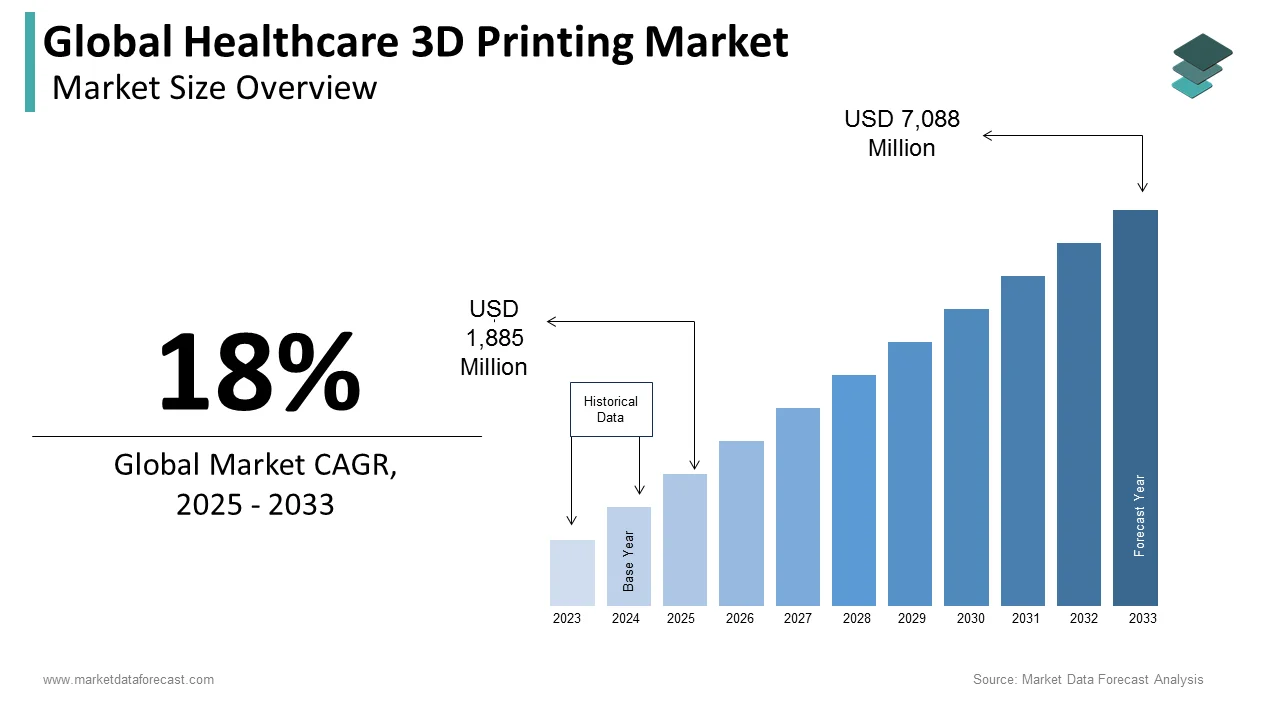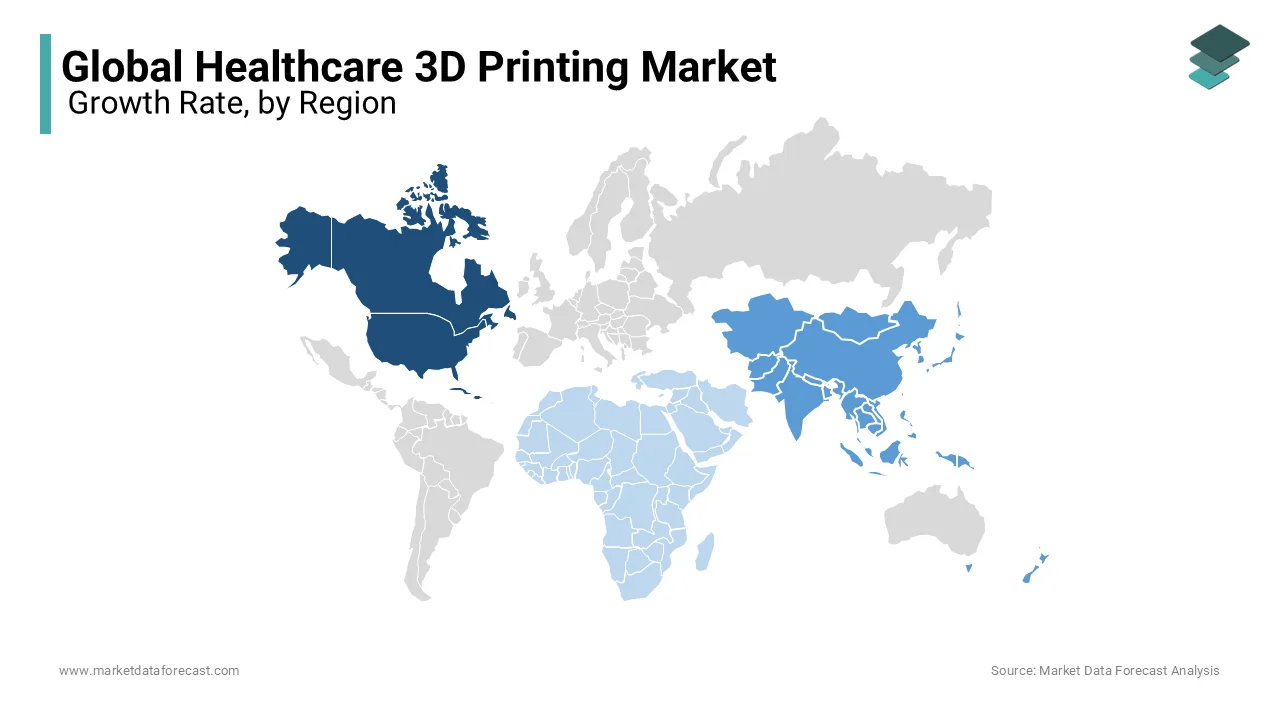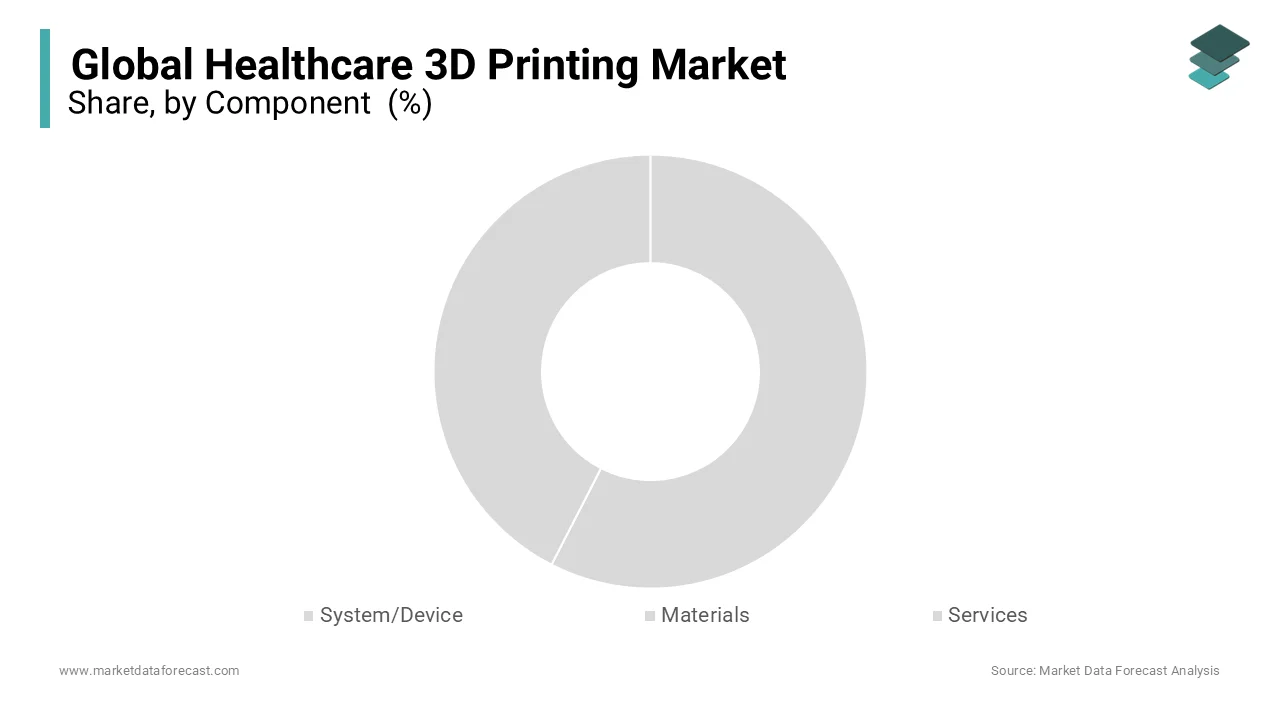Global Healthcare 3D Printing Market Size, Share, Trends & Growth Forecast Report By Component, Technology, Application, End-User and Region (North America, Europe, Asia-Pacific, Latin America, Middle East and Africa), Industry Analysis From 2025 To 2033.
Global Healthcare 3D Printing Market Size
The size of the global healthcare 3D printing market was worth USD 1,598 million in 2024. The global market is anticipated to grow at a CAGR of 18% from 2025 to 2033 and be worth USD 7,088 million by 2033 from USD 1,885 million in 2025.

3D printing is undoubtedly one of the disruptive technologies shaping industries towards betterment. It has a wide range of healthcare industry applications, rapidly evolving over the past few years. The usage of 3D printing in the healthcare industry has been in practice since 1990, and in recent times, the demand for these technologies has increased at a greater pace as they are much more accessible and affordable. 3D Printing is now used to make Three-dimensional objects from a CAD model by adding material layer by layer, which is why 3D Printing is also known as additive manufacturing. Healthcare 3D printing is significantly helpful for hearing aids, dental implants, prostheses, and contact lenses customized to the individual and thus helps treat many problems. 3D Printing is also used in the manufacturing of hip and knee implants.
MARKET DRIVERS
The growth of the healthcare 3D printing market is majorly driven by the increase in the geriatric population worldwide.
The WHO says the number of people more than 60 years of age is anticipated to reach 1.4 billion worldwide by 2030. In addition, the prevalence of cardiovascular, orthopaedic, and other diseases has increased the risk factor for us and increased the demand for 3D printing medical devices. According to the Centers for Disease Prevention and Control (CDC), CVDs are one of the leading causes of death in the United States, and one person dies from CVDs per every 34 seconds in the United States. A total of 697,000 people died of CVDs in the United States in 2020.
The growing investments from various governments to conduct R&D of healthcare 3d printing technology thus ensure favorable growth in the future. 3D printing technology can revolutionize the healthcare industry by allowing the customized creation of medical devices and implants, which can offer more efficient and cost-effective manufacturing processes for these products. For instance, the National Institute of Health (NIH) and The European Union have invested considerably to research 3D printing for healthcare applications.
Furthermore, the increasing healthcare quality everywhere has made this technology accessible to most people. Healthcare professionals have started exploring this technology to reduce the risk of using anesthesia during long surgeries. The reduction in cost & time in the medical procedures for transplants and surgeries and rapid expansion of the customer base is one of the primary drivers of the global Healthcare 3D Printing Market. The best suitability as an alternative to animal testing with the organs made from 3D printing technology, the customizations offered by this technology, and efficient material usage are the fuelling factors of the market.
MARKET RESTRAINTS
The primary restraint for the healthcare 3D printing market is to reduce the high costs associated with the 3D printing technology so that even developing countries can benefit from this new system. The lack of a regulatory framework and quality has hampered the market's growth. The reimbursement challenges faced by people opting for 3D devices have also slowed market growth. The lack of technology in many countries also challenges the market. The stringent copyright & patent infringement systems and concerns regarding mechanical properties & biocompatibility are the challenges that are hindering the global Healthcare 3D Printing Market. Also, the lack of quality, regulatory frameworks for 3D printers, and inadequate technical knowledge about 3D printing technology in developing economies like India, China, etc., are considered the restraints of the market.
REPORT COVERAGE
|
REPORT METRIC |
DETAILS |
|
Market Size Available |
2024 to 2033 |
|
Base Year |
2024 |
|
Forecast Period |
2025 to 2033 |
|
CAGR |
18% |
|
Segments Covered |
By Component, Technology, Application, End-User, and Region. |
|
Various Analyses Covered |
Global, Regional & Country Level Analysis, Segment-Level Analysis, DROC, PESTLE Analysis, Porter’s Five Forces Analysis, Competitive Landscape, Analyst Overview of Investment Opportunities |
|
Regions Covered |
North America, Europe, APAC, Latin America, Middle East & Africa |
|
Market Leaders Profiled |
3D Systems Corporation, Exone, Formlabs, GE, Materialise NV, Oxferd Performance Materials, Inc., Organovo Holdings, Inc., Proto Labs, SLM Solutions Group AG, Stratasys Ltd., Aspect Biosystems, Cellink, Renishaw, Prodways, and EnvisionTEC., and Others. |
SEGMENTAL ANALYSIS
By Component Insights
Based on the component, the system/device sub-segment had the dominant market share in 2024 and is expected to grow at a promising rate during the forecast period. The main factor responsible for the growth is the increased adoption of 3D printing technology worldwide. The technological advancements in 3D Printing and Software have made the transition much smoother and more effective. In addition, the increased investments in Research and Development have ensured that technology is getting evolved to cater to the needs of rapidly expanding needy patients.
The materials sub-segment had the second-largest market share in 2024 and is expected to witness the fastest growth during the forecast period. The increased adoption of 3D technology and increased usage of 3D Printing has increased the demand for this sub-segment; thus, an increase in revenue is expected in the future.
By Technology Insights
Based on technology, the droplet deposition segment had the largest share of the global healthcare 3d printing market in 2024.
By Application Insights
The external wearable devices segment dominated the market in 2024 from the application segmentation, and the projected growth is positive. The main factor responsible for development is the increased usage of 3D printing technology to help patients deal with physical and internal bodily problems.
The Implants sub-segment is expected to grow at a healthy rate during the forecast period. The rise in population, and thus the prevalence of different diseases, has driven the market's growth. In addition, collaborations between companies and research Institutes have also led to more innovations that are more useful and effective.
By End-User Insights
Based on the end-user, the medical and surgical centers had the largest market share in 2024, and the projected growth rate is increasing in the forecast period. The increasing population and rising cases of people affected by diseases are majorly responsible factors for significant revenue share. In addition, the easy accessibility and surgical procedures have ensured positive market growth.
The pharmaceutical and biotechnology companies segment had the second-largest global market share in 2024. The segment's growth is attributed to the increased research and development of this technology due to increasing demand. In addition, the collaboration between companies has led to the development of various useful and technologically advanced devices.
REGIONAL ANALYSIS
North America will dominate the healthcare 3D printing market in 2024.
It is also expected to continue its dominance during the forecast period. The market's growth in this region is attributed to various technological advancements, widespread adoption of the 3D printing technology in the area, an increase in research & development investments, and several collaborations between academic & commercial organizations. North America dominates the global healthcare 3D printing market in terms of share, and the growth rate projected is complimentary during the forecast period. The main reason contributing to the high growth rate is increasing healthcare expenditure and the sophisticated healthcare infrastructure of this region. In addition, the increase in research and development for this technology has further increased the use of this technology.

The Asia Pacific market had the second-largest revenue share in 2019 and is expected to grow at the highest rate among all the regions. The rise in population in countries like India and China has also led to increased cardiovascular and orthopedic disease cases, improving market growth. In addition, government initiatives have boosted the market and its prospects in the future.
The European region had the third-largest market share in 2021. The rise in the quality of healthcare facilities and the increasing geriatric population in the region is anticipated to result in the growth of the regional market.
Regions such as Latin America, the Middle East, and Africa are expected to showcase a healthy CAGR in the coming years.
KEY MARKET PLAYERS
Companies playing a prominent role in the global healthcare 3D printing market include 3D Systems Corporation, Exone, Formlabs, GE, Materialise NV, Oxferd Performance Materials, Inc., Organovo Holdings, Inc., Proto Labs, SLM Solutions Group AG, Stratasys Ltd., Aspect Biosystems, Cellink, Renishaw, Prodways, and EnvisionTEC, and Others.
RECENT HAPPENINGS IN THE MARKET
- In January 2020, 3D Systems, a company that engineers, manufactures, and sells 3D printers headquartered in Rock Hill, South Carolina, was developing tissue and scaffold bioprinting processes for third-party companies, aiming to expedite the advancements in the biomedical industries by partnering with CollPlant Biotechnologies CLGN.
- Formlabs announces a large format 3D medical and dental printer.
- In October 2020, 3D Systems received FDA 510(k) clearance for maxillofacial surgical guides 3D printed using its LaserForm Ti and DuraForm ProX PA materials.
MARKET SEGMENTATION
This research report on the global healthcare 3D printing market has been segmented and sub-segmented based on component, technology, application, end-user, and region.
By Component
- System/Device
- Materials
- Services
By Technology
- Droplet Deposition (DD)
- Fused Deposition Modeling (FDM) Technology
- Low-temperature Deposition Manufacturing (LDM)
- Multiphase Jet Solidification (MJS)
- Photopolymerization
- Stereolithography (SLA)
- Continuous Liquid Interface Production (CLIP)
- Two-photon polymerization (2PP)
- Laser Beam Melting
- Selective Laser Sintering (SLS)
- Selective Laser Melting (SLM)
- Direct Metal Laser Sintering (DMLS)
- Electronic Beam Melting (EBM)
- Laminated Object Manufacturing
By Application
- External Wearable Devices
- Clinical Study Devices
- Implants
- Tissue Engineering
By End-User
- Medical & Surgical Centers
- Pharmaceutical & Biotechnology Companies
- Academic Institutions
By Region
- North America
- Europe
- Asia Pacific
- Latin America
- Middle East & Africa
Frequently Asked Questions
How big is the global healthcare 3D printing market?
The global healthcare 3D printing market was valued at USD 1,598 million in 2024.
What is the growth rate of the global healthcare 3D printing market?
The global healthcare 3D printing market is anticipated to grow at a CAGR of 18% from 2025 to 2033.
Which segment by component led the 3d printing healthcare market in 2024?
Based on component, the systems segment accounted for the largest share of the healthcare 3d printing market in 2024.
Who are the major players in the healthcare 3d printing market?
3D Systems Corporation, Exone, Formlabs, GE, Materialise NV, Oxferd Performance Materials, Inc., Organovo Holdings, Inc., Proto Labs, SLM Solutions Group AG, Stratasys Ltd., Aspect Biosystems, Cellink, Renishaw, Prodways, and EnvisionTEC. are a few of the noteworthy players in the healthcare 3D printing market.
Related Reports
Access the study in MULTIPLE FORMATS
Purchase options starting from $ 2500
Didn’t find what you’re looking for?
TALK TO OUR ANALYST TEAM
Need something within your budget?
NO WORRIES! WE GOT YOU COVERED!
Call us on: +1 888 702 9696 (U.S Toll Free)
Write to us: [email protected]

